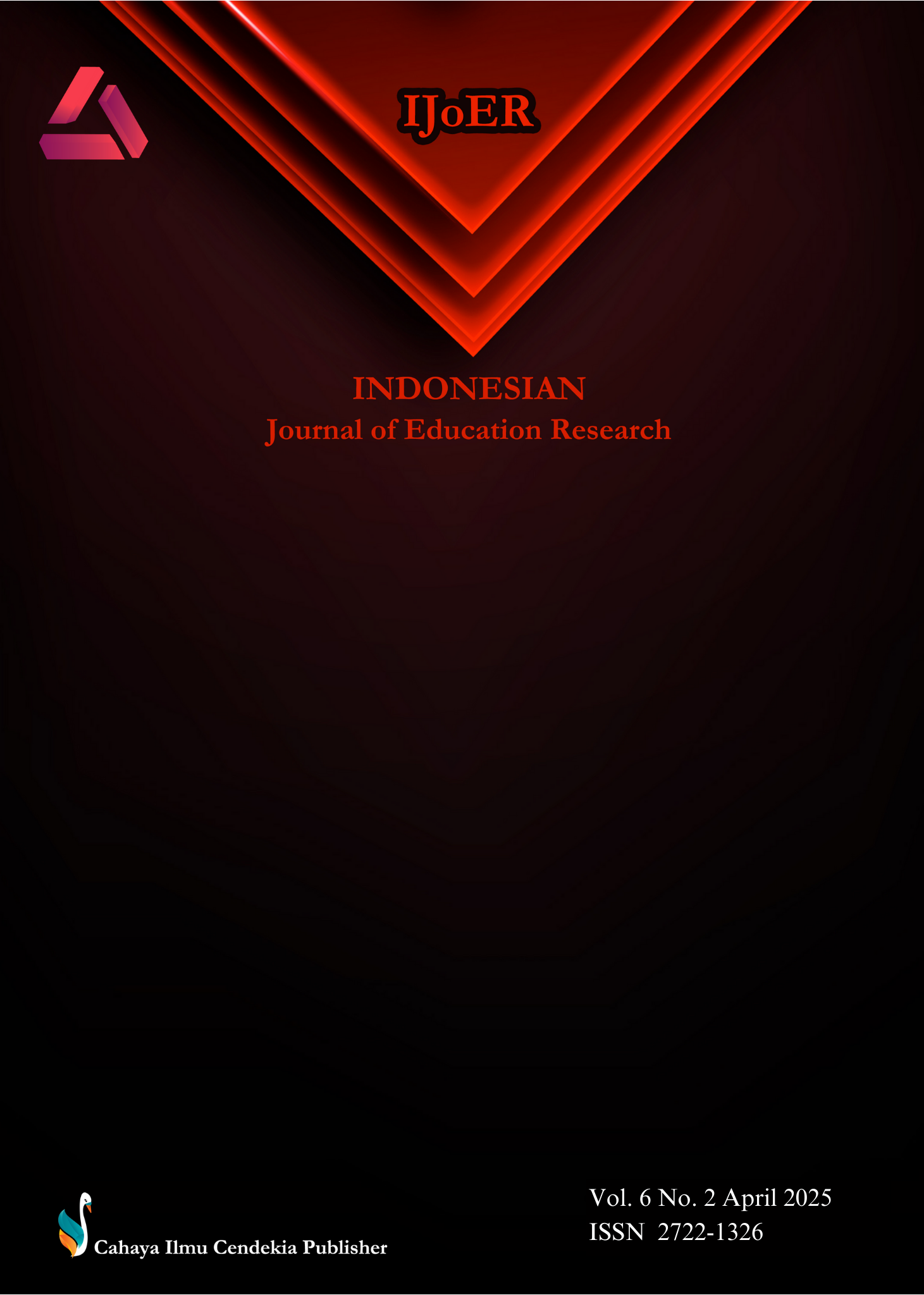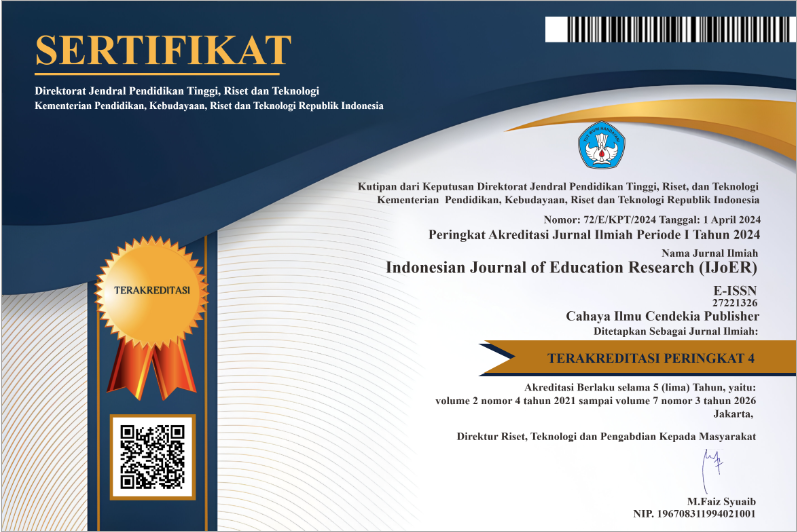Learning With AI: The Impact of ChatGPT and QuillBot to Approaches to Learning (ATL) Skills of Students
Abstract
Purpose of the study: This study aimed to determine the experiences and perspectives of students of Second Language English (ESL) or English as Foreign Language (EFL) Year 2 International Baccalaureate Diploma Programme (IB DP), on how Artificial Intelligence - powered assisted tools impact their Approaches to Learning (ATL) skills.
Methodology: This study adopted a narrative approach, an appropriate theoretical basis with Braun and Clarke's Thematic Analysis for qualitative data to uncover codes, sub themes and themes. The method used to gather data was a face-to-face Focus Group Discussion (FGD) with thirteen Year 2 IB DP students (Grade 12) participants. The FGD was recorded and transcribed.
Main Findings: The use of Artificial Intelligence tools had positive impact to a lesser extent and temporarily helpful on their thinking, research and writing skills, with highly positive effect to self-management skills but detrimental in the long term. Overall, AI tools can cause adverse effects on the users, but if it is properly integrated and correctly use with appropriate guidelines, AI tools have the potential to be beneficial for learners.
Novelty/Originality of this study: This study explores the impact of specific AI tools, ChatGPT and QuillBot, on the Approaches to Learning skills of students at an IB world school. This study focused on writing, thinking, research, and self-management skills from the perspective of students, themselves, hence, offering insights how AI tools enhance or degrade skills that could shape future educational policies.
References
“Diploma Programme,” IBO.org. https://www.ibo.org/programmes/diploma-programme/.
S. Ledger, “The International Baccalaureate standards and practices as reflected in the literature (2009–2016),” International Schools Journal, vol. 37, no. 1, pp. 32–44, Jan. 2017.
“International Baccalaureate Diploma Programme Subject Brief,” ibo.org.
A. Gan, “Chinese students’ adjustment to the International Baccalaureate Diploma Programme: Experiences of an Australian high school,” Journal of Research in International Education, vol. 8, no. 3, pp. 283–304, Nov. 2009, doi: 10.1177/1475240909345815.
E. Wright and M. Lee. “Developing skills for youth in the 21st century: The role of elite International Baccalaureate Diploma Programme schools in China.” International Review of Education 60(2): 199-216. March 2014. doi:10.1007/s11159-014-9404-6
D. Anu & L. Ansah. “Education in the Era of Generative Artificial Intelligence (AI): Understanding the Potential Benefits of ChatGPT in Promoting Teaching and Learning.” Journal of AI. 7. December 2023. doi: 10.61969/jai.1337500.
K. Hu. “ChatGPT sets record for fastest-growing user base-analyst note.” Reuters.
“Popular AI-Powered Writing Platform, QuillBot, Launches Translation Tool to Help Bridge Language Gaps and Coach Writers.”
B. Lund. “A brief review of chatgpt its value and underlying gpt technology.” researchgate.net . January 2023. doi: 10.13140/RG.2.2.28474.06087/1
A. Haensch, T. R. Rehatschek, and H. M. Berghold, “ChatGPT in higher education—Evaluation of students’ and lecturers’ attitudes towards artificial intelligence,” Educ. Sci., vol. 13, no. 3, p. 315, Mar. 2023, doi: 10.3390/educsci13030315.
A. Mohammed, D. I. Palese, R. D. Palese, and J. A. Macapaz, “ChatGPT and English language learning: Perceptions of students and teachers,” Eur. J. Lang. Linguist. Stud., vol. 6, no. 2, pp. 119–132, 2023.
N. T. T. Nguyen, “Effects of using QuillBot paraphrasing tool on English-majored students’ writing skills at Dong Thap University,” Res. Soc. Sci. Technol., vol. 8, no. 2, pp. 76–90, Dec. 2023, doi: 10.46303/ressat.2023.11.
E. Kasneci, S. S. Kitchen, J. Klingler, T. T. Schaub, and F. Kasneci, “ChatGPT for good? On opportunities and challenges of large language models for education,” Learn. Individ. Differ., vol. 103, p. 102274, Mar. 2023, doi: 10.1016/j.lindif.2023.102274.
S. Aqilah, “The implication of QuillBot paraphrasing tool usage on students’ academic integrity and writing competence,” presented at The 3rd Int. Conf. Educ. Sci. Technol. (ICEST), 2023.
A. Kholis, K. H. Lisan, and U. U. Azmi, “Empowering Students through AI: Integrating Artificial Intelligence (AI) Tools in Academic Writing Classes,” presented at The 5th Int. Conf. on Teacher Education and Professional Development (InCoTEPD), Yogyakarta, Indonesia, Jun. 25–26, 2024.
Y. Huang, P. Chen, H. Lee, F. E. Sandnes, and T. Wu, “ChatGPT-Enhanced Mobile Instant Messaging in Online Learning: Effects on Student Outcomes and Perceptions,” Comput. Human Behav., vol. 168, p. 108659, Jul. 2025, doi: 10.1016/j.chb.2025.108659.
W. Xiaoyu, Z. Zainuddin, and C. H. Leng, “Generative artificial intelligence in pedagogical practices: A systematic review of empirical studies (2022–2024),” Cogent Educ., vol. 12, no. 1, Apr. 2025, doi: 10.1080/2331186x.2025.2485499.
A. A. Funa and R. A. E. Gabay, “Policy guidelines and recommendations on AI use in teaching and learning: A meta-synthesis study,” Social Sci. Humanit. Open, vol. 11, p. 101221, 2024, doi: 10.1016/j.ssaho.2024.101221.
M. Lodi and S. Martini, “Computational Thinking, Between Papert and Wing,” Sci. Educ., vol. 30, pp. 883–908, Apr. 2021, doi: 10.1007/s11191-021-00202-5.
I. Tuomi, “The Impact of Artificial Intelligence on Learning, Teaching, and Education: Policies for the Future,” European Commission, 2018, doi: 10.2760/12297.
F. Ouyang and P. Jiao, “Artificial intelligence in education: The three paradigms,” Comput. Educ.: Artif. Intell., vol. 2, p. 100020, 2021, doi: 10.1016/j.caeai.2021.100020.
I. Goldstein and S. Papert, “Artificial intelligence, language, and the study of knowledge,” Cognitive Sci., vol. 1, no. 1, pp. 84–123, Jan. 1977, doi: 10.1016/S0364-0213(77)80006-2.
P. Winston, “Marvin L. Minsky (1927–2016),” Nature, Feb. 2016.
A. Bandura, Social Foundations of Thought and Action: A Social Cognitive Theory. Englewood Cliffs, NJ: Prentice-Hall, 1986.
C. H. Liu and R. Matthews, “Vygotsky’s philosophy: Constructivism and its criticisms examined,” Int. Educ. J., vol. 6, no. 3, pp. 386–399, Jul. 2005.
L. Vygotsky, Mind in Society: The Development of Higher Psychological Processes. Cambridge, MA: Harvard Univ. Press, 1978, doi: 10.2307/j.ctvjf9vz4.
T. Baker, L. Smith, and N. Anissa, “Educ-AI-tion rebooted? Exploring the future of artificial intelligence in schools and colleges,” Nesta, Feb. 2019.
C. P. Rose, E. A. McLaughlin, R. Liu, and K. R. Koedinger, “Explanatory learner models: Why machine learning (alone) is not the answer,” Br. J. Educ. Technol., vol. 50, no. 6, pp. 2943–2958, Aug. 2019, doi: 10.1111/bjet.12858.
Z. Austin and J. Sutton, “Qualitative Research: Data Collection, Analysis, and Management,” Can. J. Hosp. Pharm., vol. 68, no. 3, pp. 226–231, May–Jun. 2015, doi: 10.4212/cjhp.v68i3.1456.
“Frameworks for Qualitative Research,” SAGE Publishing. https://us.sagepub.com/sites/default/files/upm-binaries/13887_Chapter5.pdf.
L. E. Tomaszewski, J. Zarestky, and E. Gonzalez, “Planning Qualitative Research: Design and Decision Making for New Researchers,” Int. J. Qual. Methods, vol. 19, 2020, doi: 10.1177/1609406920967174.
D. J. Clandinin and F. M. Connelly, Narrative Inquiry: Experience and Story in Qualitative Research. San Francisco: Jossey-Bass, 2000.
V. Braun and V. Clarke, “Thematic analysis,” in APA Handbook of Research Methods in Psychology: Research Designs, vol. 2, H. Cooper et al., Eds. Washington, DC: APA, 2012, pp. 57–71.
V. Braun, V. Clarke, N. Hayfield, and G. Terry, “Answers to frequently asked questions about thematic analysis,” 2019.
D. Byrne, “A worked example of Braun and Clarke’s approach to reflexive thematic analysis,” Qual. Quant., vol. 56, pp. 1391–1412, Jun. 2022, doi: 10.1007/s11135-021-01182-y.
V. Braun and V. Clarke, “Thematic analysis,” in Encyclopedia of Critical Psychology, T. Teo, Ed. New York: Springer, 2014, pp. 1947–1952.
V. Braun, V. Clarke, and P. Terry, “Using Thematic Analysis in Sport and Exercise Research,” in Routledge Handbook of Qualitative Research in Sport and Exercise, B. Smith and A. C. Sparkes, Eds. London: Routledge, 2016, pp. 191–205.
M. Q. Patton, Qualitative Evaluation and Research Methods, 2nd ed. Thousand Oaks, CA: Sage, 1990.
J. Han et al., “RECIPE: How to integrate ChatGPT into EFL writing education,” in Proc. 10th ACM Conf. Learning @ Scale, pp. 416–420, Jul. 2023, doi: 10.1145/3573051.3596200.
C. K. Lo, “What is the impact of ChatGPT on education? A rapid review of the literature,” Educ. Sci., vol. 13, no. 4, p. 410, Apr. 2023, doi: 10.3390/educsci13040410.
H. A. Bilal, R. Faiz, I. Asghar, and A. Safdar, “Optimizing ChatGPT as a writing aid for EFL learners: Balancing assistance and skill development in writing proficiency,” Linguist. Forums, vol. 5, no. 3, p. 3, Oct. 2023, doi: 10.53057/linfo/2023.5.3.3.
R. Kostka and R. Toncelli, “Exploring applications of ChatGPT to English language teaching: Opportunities, challenges, and recommendations,” Electron. J. Engl. Second Lang., vol. 27, no. 3, Nov. 2023, doi: 10.55593/ej.27107int.
C. Ho, “The QuillBot grammar checker: Friend or foe of ESL student writers?,” J. Creative Pract. Lang. Learn. Teach., vol. 10, May 2022.
K. K. Lo, K. F. Hew, and M. S. Jong, “The influence of ChatGPT on student engagement: A systematic review and future research agenda,” Comput. Educ., vol. 219, p. 105100, Oct. 2024, doi: 10.1016/j.compedu.2024.105100.
Y. Wardat et al., “ChatGPT: A revolutionary tool for teaching and learning mathematics,” Eurasia J. Math. Sci. Technol. Educ., vol. 19, no. 7, p. e2286, Jul. 2023, doi: 10.29333/ejmste/13272.
M. Rahman et al., “ChatGPT and academic research: A review and recommendations based on practical examples,” J. Educ. Manag. Dev. Stud., vol. 3, no. 1, pp. 1–12, Mar. 2023, doi: 10.52631/jemds.v3i1.175.
L. Giray, J. Jacob, and D. L. Gumalin, “Strengths, weaknesses, opportunities, and threats of using ChatGPT in scientific research,” Int. J. Technol. Educ., vol. 7, no. 1, pp. 40–58, Feb. 2024, doi: 10.46328/ijte.618.
T. Famaye et al., “‘What makes ChatGPT dangerous is also what makes it special’: High-school student perspectives on the integration or ban of artificial intelligence in educational contexts,” Int. J. Technol. Educ., vol. 7, no. 2, pp. 174–199, 2024, doi: 10.46328/ijte.651.
Y. K. Dwivedi et al., “‘So what if ChatGPT wrote it?’ Multidisciplinary perspectives on opportunities, challenges and implications of generative conversational AI for research, practice and policy,” Int. J. Inf. Manag., vol. 71, p. 102642, Aug. 2023, doi: 10.1016/j.ijinfomgt.2023.102642.
D. Gödde et al., “A SWOT (strengths, weaknesses, opportunities, and threats) analysis of ChatGPT in the medical literature: Concise review,” J. Med. Internet Res., vol. 25, p. e49368, May 2023, doi: 10.2196/49368.
A. R. Vargas-Murillo, I. N. M. de la Asuncion, and F. de J. Guevara-Soto, “Challenges and opportunities of AI-assisted learning: A systematic literature review on the impact of ChatGPT usage in higher education,” Int. J. Learn. Teach. Educ. Res., vol. 22, no. 7, pp. 122–135, 2023, doi: 10.26803/ijlter.22.7.7.
A. Iskender, “Holy or unholy? An interview with OpenAI’s ChatGPT,” Eur. J. Tourism Res., vol. 34, pp. 3414–3414, Mar. 2023, doi: 10.54055/ejtr.v34i.3169.
P. Zhang and G. Tur, “A systematic review of ChatGPT use in K-12 education,” Eur. J. Educ., Dec. 2023, doi: 10.1111/ejed.12599.
R. Gaboy, M. Mabalay, M. Mercado, and B. Romblon, “Coping with the new norm: ICT-pedagogy integration awareness and competencies of TEI faculty,” J. Res. Policy Pract. Teach. Teach. Educ., Dec. 2020, doi: 10.37134/jrpptte.vol10.2.4.2020.
Copyright (c) 2025 Mary Joy Cabreza Juntarciego, Regidor G. Gaboy, Ma. Ruby Hiyasmin M. Delos Santos, Leila M. Collantes

This work is licensed under a Creative Commons Attribution 4.0 International License.
Authors who publish with this journal agree to the following terms:
- Authors retain copyright and acknowledge that the Indonesian Journal of Education Research (IJoER) is the first publisher licensed under a Creative Commons Attribution 4.0 International License.
- Authors are able to enter into separate, additional contractual arrangements for the non-exclusive distribution of the journal's published version of the work (e.g., post it to an institutional repository or publish it in a book), with an acknowledgment of its initial publication in this journal.
- Authors are permitted and encouraged to post their work online (e.g., in institutional repositories or on their website) prior to and during the submission process, as it can lead to productive exchanges and earlier and greater citation of published work.







.png)
.png)




















